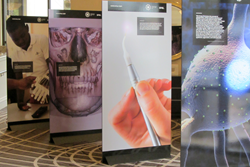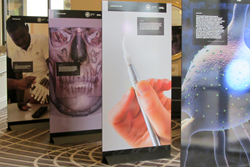Diagnostics, Treatments for Cancer, Heart Surgery Advanced at SPIE Medical Imaging


BELLINGHAM, Washington, and ORLANDO, Florida, USA (PRWEB) March 24, 2015
Improved computer-aided diagnostics (CAD) for detecting lung cancer got a push forward via a well-received Grand Challenge competition which culminated at the recent SPIE Medical Imaging 2015 symposium in Orlando, Florida. The symposium ran 21-27 February, and attracted 1,100 researchers, scientists, and clinicians.
The first-ever LUNGx Grand Challenge, aimed at developing quantitative image analysis methods for the diagnostic classification of malignant and benign lung nodules, was sponsored by event organizer SPIE, the international society for optics and photonics; the American Association of Physicists in Medicine (AAPM); and the U.S. National Cancer Institute (NCI).
The results of 13 algorithms from 11 groups were compared, more than average for other NCI Grand Challenges, noted Lubomir Hadjiiski (University of Michigan Health System). Hadjiiski, along with Georgia Tourassi (Oak Ridge National Lab), chaired the CAD conference, which hosted the LUNGx Challenge event.
Judges named a team led by Lyndsey Pickup of Mirada Medical UK as the winner. A team led by Yoganand Balagurunathan of the Moffitt Cancer Center at the University of Arizona was named runner-up.
The LUNGx Grand Challenge enabled entrants to compare their algorithms in a structured, direct way using the same data sets and in the process, play a vital role in the selection of promising classes of algorithms and systems for further clinical translational efforts. Goals are to prompt advances in CAD and thereby precision medicine.
Hadjiiski said organizers deemed the LUNGx challenge to be “a very successful pilot, and that it worked well to hold the challenge coincident with the CAD conference. The topic of classification of lung nodules was a new direction for such challenges, he noted, as past challenges have had to do with segmentation.
Additional information and updates will be published soon in the Journal of Medical Imaging.
Featured talks and technical sessions at Medical Imaging covered rapid advances in imaging, sensing, and their underlying mathematics and their significant impacts on numerous areas of medicine.
Among the reports on promising progress in new methods and technologies for heart surgery and cancer detection and treatment was the plenary talk, by the Mayo Clinic’s Douglas Packer. He described research finding that combining real-time imaging and fusing modalities provides the best results for guiding intracardiac and noninvasive extracorporeal ablation. (More details from Packer’s talk, keynote talks, and technical session reports are in the event news blog.)
Treating cardiac arrhythmias through ablation, or scarring of heart tissue, presents clinicians with many challenges, Packer said. Ablation can be a lengthy surgery —as long as 12 hours —and visualizing defective areas of a beating heart in motion can be difficult. The ability to accurately visualize the area in real time facilitates a more effective surgery.
A session in the Digital Pathology conference highlighted progress toward automated tools for more effective diagnosis and clinical decisions in treating gastro-intestinal and genito-urinary cancers.
Geert Litjens of Radboud University, Nijmegen Medical Center, demonstrated an automated system for grading and analyzing digitized whole-slide images for prostate cancer diagnosis, while Case Western researcher Asha Singanamalli showed a technique which enables distinguishing between cancerous and benign tissue in the prostate by detecting differences in co-occurring glands.
Oscar Geessink of the University of Twente presented an automated tool for objective quantification of stroma and tumor proportions in studying colorectal cancer, which demonstrated less variability than human observers.
In a session on Treatment Planning and Robotic Systems detailing surgical strategies and improving patient experience, Yiyuan Zhao of Vanderbilt University presented work on improving cochlear implants. The Vanderbilt group has developed an image-guided, automated way to determine which electrodes to activate once the device has been implanted, which is key to optimizing the implant’s ability to provide sound signals to the brain.
Other presentations covered a nonholonomic catheter path reconstruction for treating prostate cancer, from researchers at Queen’s University in Canada; navigation tools for brachytherapy, from the Canadian Surgical Technologies and Advanced Robotics center; and methods to noninvasively generate patient-specific pulmonary vascular models to improve surgery outcomes and decrease the need for exploratory surgeries, from a team at the University of Florida.
Conference proceedings are being published online in the SPIE Digital Library as approved, with CD and print publication to follow.
Symposium chairs were David Manning of Lancaster University and Steven Horii of the University of Pennsylvania Health System. Berkman Sahiner, U.S. Food and Drug Administration, has accepted the role of symposium cochair for 2016. Next year’s event will be held 28 February through 3 March in San Diego, California.
About SPIE
SPIE is the international society for optics and photonics, a not-for-profit organization founded in 1955 to advance light-based technologies. The Society serves nearly 256,000 constituents from approximately 155 countries, offering conferences, continuing education, books, journals, and a digital library in support of interdisciplinary information exchange, professional networking, and patent precedent. SPIE provided more than $ 3.4 million in support of education and outreach programs in 2014. http://www.spie.org
Related Mathematics Press Releases